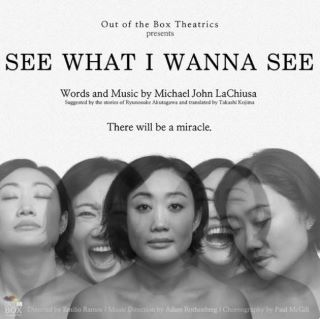I’D LOVE TO FIGURE OUT
WHAT YOU WANT ME TO SEE
It is extremely hard to translate the work of writers as ingenious and imaginative as RyÅ«nosuke Akutagawa, the father of Japanese short stories, into plays or films without falling into flat versions of the complex originals; very few artists have succeeded although many have tried. Presented at 154 Christopher Street by Out of the Box Theatrics, See What I Wanna See, the murky, flawed, complicated and sometimes beautiful 2005 musical by Michael John LaChiusa — loosely (very loosely) based on three famous short stories by Akutagawa — “Kesa and Morito”, “Dragon: the Old Potter’s Tale” and “In a Grove” (the inspiration for Akira Kurosawa’s 1950 film Rashomon) — has all the right elements but ends up being a confusing patchwork of traditional musical pieces with Asian overtones.
Kelvin Moon Loh, Zachary Noah Piser, Sam Simahk, and Marina Kondo
It is supposed to unfold like a classical Japanese screen painting but it is difficult to understand what is happening unless you read the original stories because both acts start with an abstract prologue inspired by the Japanese medieval tale of lovers/killers Kesa and Morito. It’s the story of a samurai’s obsession for a noblewoman who is already married, of the hate, fear, lust, and love they feel for each other. Kesa (Marina Kondo) is about to kill Morito (Sam Simahk) while they are making love but we don’t know why. We hear that “my husband knows my secret” but the mystery and depth of this sinister act is completely lost in the lyrics and the music tones used. The song “Kesa” that opened the show, is too happy and has too many high notes to bring us into the fragility and darkness of the human mind described by Akutagawa.
Marina Kondo
After the prologue, we end up in New York City in 1951. A man has been killed in Central Park. An arched tunnel covered by leaves (set design by Emmie Finckel) and a shadowed stage apron announce a film noir atmosphere: there is a diva, a dead husband, and a bad man — the public is the detective. Different characters come up to give us their diverse perspective on the same crime, starting with the janitor of a movie theater (a lively Zachary Noah Piser); followed by Jimmy Mako, an exaggerated 50s bad-boy (Simahk); the sexy Wife (Kondo); the Husband (Kelvin Moon Loh); and an outstanding Ann Sanders as The Medium, who summons the spirit of the victim to get his version.
Ann Sanders
Act II centers on a priest who creates a hoax about a miracle. We are still in New York City but it’s 2002 in the wake of the September 11 attacks. The priest (a persuasive Piser) has heard many horrific stories related to the tragedy during Confession and he is having a crisis of faith. The second act’s more solid and coherent story better conveys the bedrock obsessions that fuel both the music and the characters (and the title for that matter), yet while the plot and acting are appealing in the more straightforward second act, most of the songs do not reflect the pathos of the events, with not enough pauses or recitative to accentuate the dramatic or funny moments, aside from a few tunes like “The Greatest Practical Joke”, sung superbly by Sanders as the priest’s only living relative, atheistic Aunt Monica.
Justin Otaki Perkins, The Husban puppet, and Sam Simahk
Since the characters’ minds are in the dark, the moon becomes extremely important and lighting designer Kat C. Zhou makes sure we pay attention to it. Justin Otaki Perkins, the Puppet Captain, together with Takemi Kitamura and Nikki Calonge, give life to the wooden marionettes; Siena Zoë Allen’s costume design is playful and catches the essence of each character in both acts; and the music direction by Adam Rothenberg is excellent, passionate and precise, as are the performances of the musicians. Emilio Ramos, the director, may have pushed the stereotypical side of the characters a bit too much to be realistic, or not enough to be campy, but his direction isn’t the problem, the complexity of the original material is. Produced very well by a company which is willing to take risks, See What I Wanna See is its own Rashomon-like puzzle whose recherché song pieces — from serviceable rather than memorable cool jazz to contemporary power ballads — can’t quite be put together. Is this what you want to see?
Kelvin Moon Loh and Zachary Noah Piser
photos © Thomas Brunot
See What I Wanna See
Out of the Box Theatrics
154 Christopher Street (formerly The New Ohio theater)
two hours and fifteen minutes with intermission
Mon & Wed-Sat at 7; Sat at 3; Sun at 3
ends on September 29, 2024
for tickets, visit OvationTix

